Marc Weidenbaum's Blog, page 102
May 9, 2023
Sound Ledger¹ (Noise, Deepfakes)
30%: Goal to reduce “the share of people ‘chronically disturbed by transport noise,’” per the European Commission’s Zero Pollution Action Plan
30%: Percentage of adults exposed to excessive noise, per “a study Apple conducted using data from its Apple Watch”
$20,000: Reported top asking price, per minute, for deepfakes on the darknet
. . .
¹Footnotes: Goal: politico.eu. Apple: cnet.com. Deepfake: kaspersky.com.
May 8, 2023
Junto Profile: Paul Beaudoin
This Junto Profile is part of an ongoing series of short Q&As that provide some background on various individuals who participate regularly in the online Disquiet Junto music community.
What’s your name? My name is Paul Beaudoin, though lately I have been toying with being DJ Shostakovich — somehow, that name amuses (and inspires) me.
Where are you located? I live in a former Soviet Union military zone in Tallinn, Estonia — though I was born in the US and spent most of my professional life in Boston. Today, I am a full-time interdisciplinary artist working fluidly with sound, paint, video, and text. But it hasn’t always been that way: long story, mostly happy ending.
I have a Ph.D. in music theory and composition from Brandeis University in the US and have pursued the academic ladder of success for many years. I didn’t realize that the ladder was disintegrating until recently. It left me frustrated, lonely, and angry. Two years ago, I read Steven Pressfield’s The War of Art. One of the final chapters changed my life.
So, while I have been a hard-core academic composer (read somewhere between Milton Babbitt’s twelve-tone serialism and Morton Feldman’s softly repeating sonorities — both, by the way, had been my teachers), today I find myself using these strategies but within the ambient soundscape. I still think about sets and orchestration, but far removed from academia. I still compose music for the concert hall, which is radically different. That work is now published by editions wandelweiser in Haan, Germany — something I am proud of.
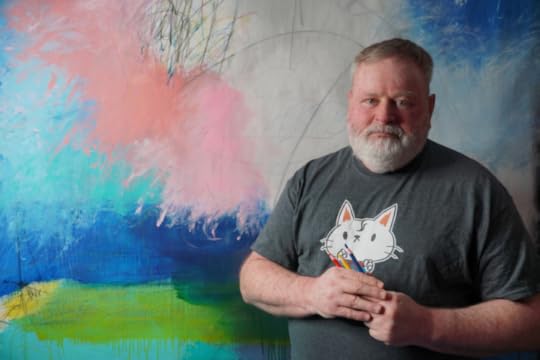
What is one good musical habit? Do not try to please your teachers or public or impress your friends or neighbors. Don’t make art to show you are a genius, a misunderstood giant, or to get laid. Make art you love, want to live with, and be at peace with. And, if you are lucky, others will respond.
And for that, yeah, be a good person.
— it’s one of the quotes I post annually on my social media.
What are your online locations? I am on the usual social media culprits for artists: Soundcloud, Instagram, and Facebook — just search by my name.
What was a particularly meaningful Junto project? The Junto Project prompts challenge me to step out of my comfort zone. For nearly my entire life, I have been a “beatless” person — with Junto projects, I find a way to include rhythm tracks and use traditional harmony and forms. I often thought I should use a pseudonym for these projects, but then I thought: Hey, this is me! Many years ago, a student told me, “All you have to do is put a beat to it, and people will listen.” So I did. For a Junto project called “the best advice I ever got,” I started with a dance hall beat and harmony and then layered all kinds of animal sounds, chanting, and noise. Before the track was released, it had more than 350 listens, which is “huge” for me.
I recently compiled a few Junto projects into a recording called “Disquiet Music,” released by Camembert Electrique. You can download it for free here: camembertelectrique.bandcamp.com.
Could you tell a story or two about studying with Morton Feldman? What a paradox Feldman was. His music lives at the border of silence (or so the canon likes us to think), but Feldman was a very imposing man. Brash and large, he spoke with the voice of an authority that was not to be questioned. In a composition seminar, there was a heated discussion about musical motion — that music somehow “moves.” Feldman insisted that music did not move, and to prove his point, he picked up a chair and threw it across the room. “There,” he practically yelled, “that’s motion.”
Does being in Tallinn sound different from being in Boston, and if so, has the location change had an impact in some way on your music? There is no doubt that my move to Tallinn influenced the radical shift my music took. There is a kind of continuous low rumble in Boston — whether it comes from the “T” or the roar of the crowd at Fenway Park (which I always heard from my apartment window). And since Boston has so many colleges, there is a constant influx of young people who come to benefit from their new independence. Parties, college-style shenanigans, arguments, you can hear it all. Here in Tallinn, the sound world is entirely different.
Estonians are, by their very nature, quiet. They do not engage in small talk and very much keep to themselves. I can go for days without having someone talk to me. There is also a deep respect for the natural environment here — so many lakes, forests, and meadows have been untouched for millennia. This quiet landscape was the perfect prescription for me to regroup. It gave me the resonance I needed to look inward; it forced me to slow down — like, really slow down. My music softened, it also got quieter, and it began to incorporate field recordings. A composer’s world is a kind of autobiography, and there can be no doubt that their environment finds its way into the work. I remember being in Boston and being asked what my music might sound like in 30 years. I joked that it would be so quiet one might doubt its existence. Now I don’t think it is a joke but a real possibility.
Hum a Few Bars
“Many of our electrical things, all around us, are constantly buzzing at 60 hertz, or a harmonic like 120 hertz. And what we’re hearing, or not hearing, is the electrical grid. The companies that manage our power, in my case, Con Edison in New York, are required by law to maintain that 60 hertz output” — thus Micah Loewinger explains the foundation of a fascinating audio forensics tool called ENF, which stands for electrical network frequency analysis.
Essentially, there’s a record of slight variations in the electrical grid, and by mapping a recording’s underlying buzz against the historical record, sleuths can identify the date and time — “almost to the exact second,” reports Loewinger — that something was taped. It’s an intriguing story about evidence hiding in plain sight, and about the way sounds that we take for granted contain meaning.
Listen to the full episode (transcript also available), which aired recently as part of the WNYC show On the Media (and which, as a bonus, opens with another sound-related story: an update on “The Unending Mystery of Havana Syndrome”). (Thanks, Rich Pettus!)
May 7, 2023
Sonic Verbs
At the end of the introduction of each issue of my This Week in Sound email newsletter I swap in a new sonic verb. This is the latest in my occasionally updated list of the words I’ve used. If you have a favorite you don’t see here, let me know. Thanks.
babble, bang, bawl, bay, blow, bombinate, burble, burr, buzz, cackle, cantillate, cheep, chirm, chirp, chirr, chirrup, chitter, churr, clang, clatter, coo, crack, crackle, croak, croon, crunch, ding, drone, echo, echolocate, fizzle, gasp, groan, growl, gurgle, harmonize, hiss, hoot, howl, hum, intone, jingle, keen, mewl, moan, mumble, murmur, mutter, nasalize, oscillate, outgribe, pop, psithurate , purr, rattle, resound, ring, roar, rumble, rustle, scream, screech, shout, shriek, sibilate, sigh, sign, sneeze, sniffle, snore, sough, splat, squall, squeak, squeal, squish, susurrate, swish, thud, toot, thrum, thwack, twang, trill, ululate, vibrate, wail, warble, wheeze, whiffle, whimper, whine, whir, whisper, whistle, yell, yelp
Out of Shape
Photographer Anton Corbijn has shot some of the most memorable album covers in the history of popular music, many resulting from lengthy collaborations with bands like U2 and Depeche Mode. He has 850 credits on Discogs. And now he has made a documentary about an even greater contribution to the visuals that package recorded music: the studio Hipgnosis, the lengthy discography of which includes Pink Floyd’s The Dark Side of the Moon, Led Zeppelin’s Houses of the Holy, and Peter Gabriel’s first three solo albums, among many others.
The film also has the perfect title, Squaring the Circle. Perhaps he, or one of his many interviewees, will answer an underlying question: why has the square, one of the great skeuomorphisms of our time, persisted as the symbol for recorded music, long after 12” LPs, 7” singles, and CDs have been supplanted by cloud-based streaming?
May 6, 2023
20% Solution
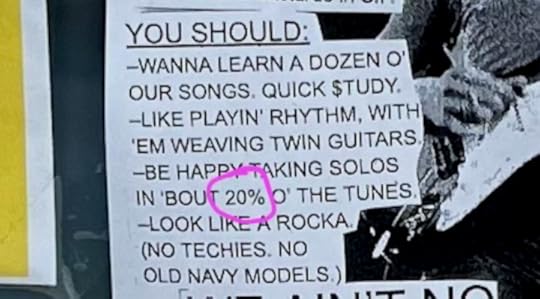
I love the percentage allotted to the incoming rhythm guitarist on this flyer a local band posted at a neighborhood record shop
Scratch Pad: News, Noise, Nunito
I do this manually each Saturday, usually in the morning over coffee: collating most of the little comments I’ve made on social media, which I think of as my public scratch pad, during the preceding week (or in this case, the past two weeks). These days that mostly means post.lurk.org (Mastodon).
▰ I signed up for the artifact.news service on my phone to check it out, and of the over 60 categories of news you are to select at least 10 from initially, music wasn’t included.
▰ Thought there was a plane flying overhead, and realized my laptop’s brown noise app had turned on
▰ Whenever someone mentions having “a part time person” as part of their project, I wonder what that entity is when it is not a person
▰ At night before I go to sleep I often record stray thoughts for morning using speech-to-text. Usually they’re comprehensible the next day. Sometimes they’re incomprehensible except as abstract song lyrics, such as what I am currently looking at: “How old I went to lock my love you got some.”
▰ Current writing font: Nunito.
May 5, 2023
All Mod Cons
I had the great pleasure recently of speaking with Tim Held for his long-running Podular Modcast, a series that takes its name from Held’s emphasis on modular synthesizers. (Yeah, that’s me on the right.) And I was honored that my episode turned out to be the show’s 250th. We had a fun and rangy chat about synths, the Disquiet Junto, online communities, instruments as works of art, field recordings, and many other topics. Our discussion is the majority of the episode, along with interspersed music performance and some gear overviews by Held. (I appeared once previously on the show, back in 2018, for the Podular Modcast’s ninth episode.)
May 4, 2023
Disquiet Junto Project 0592: Better Than One
Project-Specific Note: You may contribute more than one track this week. Usually Junto projects have a one-track-per-participant limit. This week you can do a second one. Please see additional details in Step 5 below.
Answer to Frequent Question: You don’t need to have uploaded a solo in last week’s project to participate in this week’s second phase of the trio sequence.
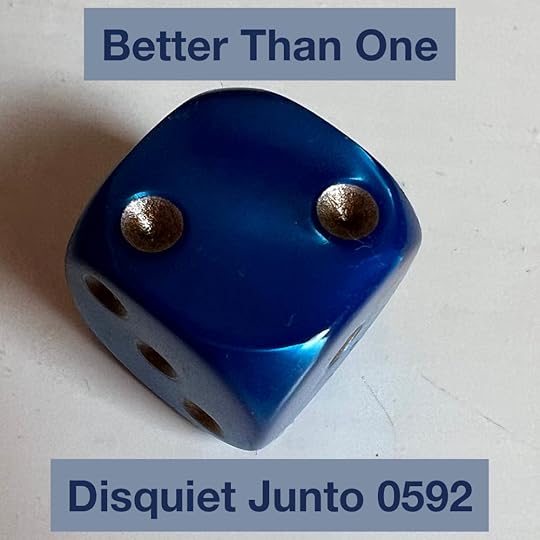
Each Thursday in the Disquiet Junto music community, a new compositional challenge is set before the group’s members, who then have just over four days to upload a track in response to the assignment. Membership in the Junto is open: just join and participate. (A SoundCloud account is helpful but not required.) There’s no pressure to do every project. It’s weekly so that you know it’s there, every Thursday through Monday, when you have the time and interest.
Deadline: This project’s deadline is the end of the day Monday, May 8, 2023, at 11:59pm (that is, just before midnight) wherever you are. It was posted on Thursday, May 4, 2023.
Tracks are added to the SoundCloud playlist for the duration of the project. Additional (non-SoundCloud) tracks appear in the lllllll.co discussion thread.
These following instructions went out to the group’s email list (at tinyletter.com/disquiet-junto).
Disquiet Junto Project 0592: Better Than One
The Assignment: Record the second third of an asynchronous trio.
Please note: While this is the second part of a three-part project, you can participate in one, two, or all three of the parts, which will occur over the course of three consecutive weeks.
Step 1: This week’s Disquiet Junto project is the second in a sequence intended to encourage and reward asynchronous collaboration. This week you’ll be adding music to a pre-existing track, which you will source from the previous week’s Junto project (disquiet.com/0592). Note that you aren’t creating a duet — you’re creating the second third of what will eventually be a trio. Important: Leave space for what is yet to come.
Step 2: The plan is for you to record a short and original piece of music, on any instrumentation of your choice, as a complement to a pre-existing track. First, however, you must select the piece of music to which you will be adding your own music. There are tracks by numerous musicians to choose from. The majority are in this playlist:
Any additional non-SoundCloud entries appear in the discussion:
https://llllllll.co/t/disquiet-junto-project-0591-the-loneliest-number/
(Note that it’s possible another track or two will pop up in or disappear from that playlist and discussion. Things are fluid on the internet.)
To select a track, you can listen through all those and choose one, or simply look around and select, or you can come up with a random approach to sifting through them.
Note: It’s fine if more than one person uses the same original track as the basis for their piece.
It is strongly encouraged that you look through the above discussion on the Lines forum, because many tracks include additional contextual information there.
Step 3: Record a short piece of music, roughly the length of the piece of music you selected in Step 2. Your track should complement the piece from Step 2, and leave room for an eventual third piece of music. When composing and recording your part, don’t alter the original piece of music at all, except to pan the original fully to the left if it hasn’t been panned left already. In your finished audio track, your new part should be panned fully to the right.
To be clear: the track you upload won’t be your piece of music alone; it will be a combination of the track from Step 2 and yours.
Step 4: Also be sure, when done, to make the finished track downloadable, because it will be used by someone else in a subsequent Junto project.
Step 5: You can contribute more than one track this week. Usually Junto projects have a one-track-per-participant limit. You can do up to two total. For the second, it’s appreciated if you try to work with a solo that no one else has used yet ( look at the project’s post on Lines, linked to in these instructions, or to the project playlist, which will be posted here once tracks start coming in). The goal is for many as people as possible to benefit from the experience of being part of an asynchronous collaboration. After a lot of detailed instruction, that is the spirit of this project.
Eight Important Steps When Your Track Is Done:
Step 1: Include “disquiet0592” (no spaces or quotation marks) in the name of your tracks.
Step 2: If your audio-hosting platform allows for tags, be sure to also include the project tag “disquiet0592” (no spaces or quotation marks). If you’re posting on SoundCloud in particular, this is essential to subsequent location of tracks for the creation of a project playlist.
Step 3: Upload your tracks. It is helpful but not essential that you use SoundCloud to host your tracks.
Step 4: Post your track in the following discussion thread at llllllll.co:
https://llllllll.co/t/disquiet-junto-project-0592-better-than-one/
Step 5: Annotate your track with a brief explanation of your approach and process.
Step 6: If posting on social media, please consider using the hashtag #DisquietJunto so fellow participants are more likely to locate your communication.
Step 7: Then listen to and comment on tracks uploaded by your fellow Disquiet Junto participants.
Step 8: Also join in the discussion on the Disquiet Junto Slack. Send your email address to marc@disquiet.com for Slack inclusion.
Note: Please post one track for this weekly Junto project. If you choose to post more than one, and do so on SoundCloud, please let me know which you’d like added to the playlist. Thanks.
Additional Details:
Length: The length is up to you. Stick to close the length of the track yours adds to.
Deadline: This project’s deadline is the end of the day Monday, May 8, 2023, at 11:59pm (that is, just before midnight) wherever you are. It was posted on Thursday, May 4, 2023.
Upload: When participating in this project, be sure to include a description of your process in planning, composing, and recording it. This description is an essential element of the communicative process inherent in the Disquiet Junto. Photos, video, and lists of equipment are always appreciated.
Download: It is always best to set your track as downloadable and allowing for attributed remixing (i.e., a Creative Commons license permitting non-commercial sharing with attribution, allowing for derivatives).
For context, when posting the track online, please be sure to include this following information:
More on this 592nd weekly Disquiet Junto project, Better Than One (The Assignment: Record the second third of an asynchronous trio), at: https://disquiet.com/0592/
About the Disquiet Junto: https://disquiet.com/junto/
Subscribe to project announcements: https://tinyletter.com/disquiet-junto/
Project discussion takes place on llllllll.co: https://llllllll.co/t/disquiet-junto-project-0592-better-than-one/
May 3, 2023
This Week in Sound: “The Silence Screamed, Terrible”
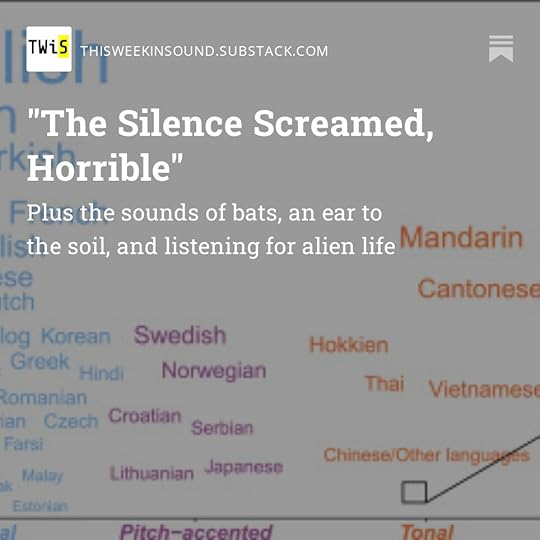
These sound-studies highlights of the week originally appeared in the May 2, 2023, issue of the Disquiet.com weekly email newsletter, This Week in Sound.
▰ GROUND SWELL: Absolutely fascinating: Listening to the earth — to soil — as a means of gauging biodiversity in a forest restoration: “With emerging sound recording technologies, ecological acoustic survey methods — also known as ‘ecoacoustics’ — are increasingly available. These provide a rapid, effective, and non-intrusive means of monitoring biodiversity. Above-ground ecoacoustics is increasingly widespread, but soil ecoacoustics has yet to be utilised in restoration despite its demonstrable effectiveness at detecting meso- and macrofauna acoustic signals.” (Thanks, Nicola Twilley!)
▰ TALK TALK: Fascinating research into how the language in which one is raised “shapes cognition,” per Courtney Hilton, a cognitive scientist at the University of Auckland in New Zealand, co-author of a study with Jingxuan Liu and others: “Speaking a native language that requires tones appears to boost perception of melody, but at the cost of rhythm.” (Thanks, Glenn Sogge!)
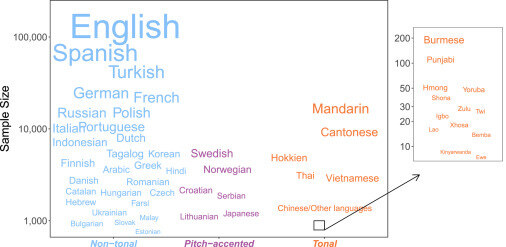 Voices Carry: A map of languages used in the study, showing sample sizes for each language (grouped by three language types)
Voices Carry: A map of languages used in the study, showing sample sizes for each language (grouped by three language types)▰ SHIP SHAPE: Novelist Robin Sloan has a new album out under the name Cotton Modules, his collaboration with musician Jesse Solomon Clark. The album, titled The Greatest Remaining Hits, was created with AI-generated voices. The name of the album comes from a tragic short story, written by Sloan, that provides a sci-fi backdrop for the overall concept. It’s a quick read, and highly recommended. The story appears on the website ooo.ghostbows.ooo one phrase or sentence at a time. The main thing I want to highlight at this juncture is a particular sentence. It will make more sense after you read the story, but the point of it is that the silence outside the spacecraft — the silence of the void of space — is all the more harrowing when there is a deep, terrible silence inside the ship. This moment is exquisite.
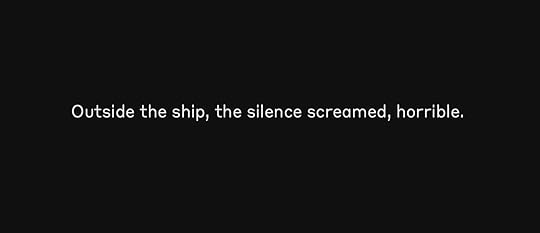
▰ OLD SCHOOL: “On one side of the road, exposed rock the color of raw liver angles up the valley slope. Entombed within this stone are the ancestors of the insects that fly and sing around me. One of this fossilized swarm bears the earliest known sound-making structure of any animal, a ridge on the wing of an ancient cricket. This fossil is the oldest direct physical evidence of sonic communication,” writes David George Haskell, describing “The First Known Earthly Voice.” (An excerpt from his excellent book Sounds Wild and Broken.)
▰ VALLEY GIRL: “My quiet place is not always without sound: sitting on a dune at dusk, I hear the soft rustling of the wind against the grains of sand,” writes Yulia Denisyuk of Jordan’s Wadi Rum valley for Condé Nast Traveler. “Leaving my tent at sunrise, I notice the bellows of camels as they return from their daily excursions. A crackling of the fire fills the long pauses in the unhurried conversations at night. The presence of this silence is a salve that helps me connect to the core of who I am.”
▰ BATS, MAN: A new exhibit at the British Library, Animals: Art, Science & Sound, is the subject of the BatChat podcast, itself a service of the Bat Conservation Trust (bats.org.uk): “Hear the recordings of horseshoe bats made on one of the first commercially available bat detectors; the Holgate Mk VI and you can see this detector within the exhibition along with photographs of the waveforms it could make from recordings. It sits alongside other important works such as Ernst Haeckel’s Kunstformen der Natur (Artforms in nature) with the plate of bats on display.” (Thanks, Lotta Fjelkegård!)
▰ OUT THERE: Via SETI: “One of the world’s most powerful radio telescope arrays is joining the hunt for signals from other galactic civilizations. The National Science Foundation’s Karl G. Jansky Very Large Array (VLA), situated about 50 miles west of Socorro, New Mexico, is collecting data that scientists will analyze for the type of emissions that only artificial transmitters make, signals that would betray the existence of a technically accomplished society. … The new processing system for SETI is dubbed ‘COSMIC’ – the Commensal Open-Source Multimode Interferometer Cluster – and is spearheaded by the SETI Institute, in collaboration with the National Radio Astronomy Observatory and the Breakthrough Listen Initiative.”
QUICK NOTES: Balls Out: Soccer becomes truly multi-lingual in Mexico now that the games are broadcast in not one (as has been the case in the past) but seven languages, the other six being major native ones: “Maya, Nahuatl, Mixteco, Chatino, Zapoteco and Mixe” (fastcompany.com). ▰ Ears Have It: Google Pixel phones may “proactively displaying warnings for potentially harmful conditions like sleep apnea” (androidpolice.com). ▰ Night Time(r): YouTube Music has added a sleep timer (9to5google.com). ▰ Casting Change: Bernie Wagenblast, “the voice of NYC’s subways,” has come out as trans (wnycstudios.org). (Thanks, Mike Rhode!) ▰ Two Wheels Bad: News of a Belgian protest against motorcycle noise (brusselstimes.com).



